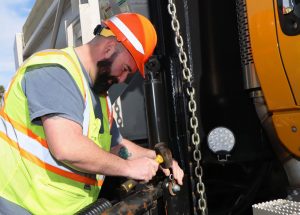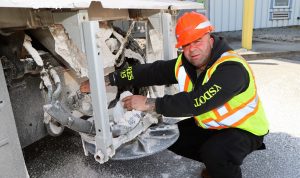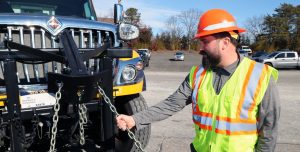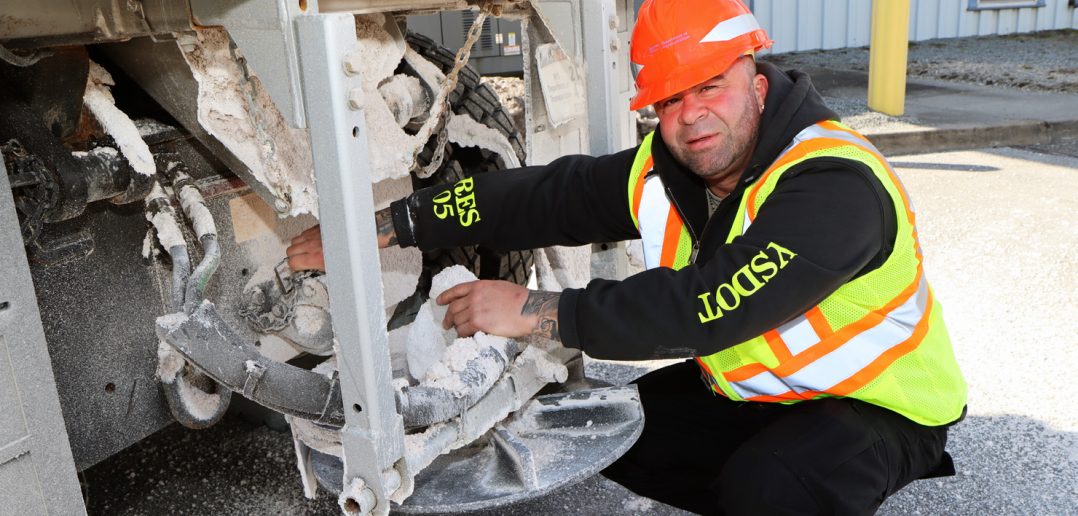MEDFORD — In addition to the risk of injury or death by motor vehicles, CSEA members who work on or near highways also face the risk of assault by angry motorists.
Our union is advocating for increased penalties for assaulting highway and Department of Motor Vehicles workers.
CSEA Region 10, Department of Transportation (Babylon) Local members are no strangers to being threatened on the job, with members having been on the receiving end of the public’s ire on more than one occasion.

Highway Maintenance Worker Patrick McDonald installs plow arm pins.
“A few years ago, President Trump was visiting the east end and we had to set up barrels on the road in a way that would provide additional security,” said Highway Maintenance Worker Patrick McDonald. “Someone came flying by us in the left lane, totally disregarding the Move Over Law, and threw a large, bottled drink at the DOT truck. There were a couple of guys sitting in the truck when it happened.”
The bottle, which McDonald compares to the size of a spray can, could have easily hit the window, shattered the glass and harmed the workers.
Soon after the incident, the culprit was found and arrested, but charges were eventually dropped, further illustrating the need for harsher penalties for attacking highway workers.
“We’ve had people be so angry that traffic is slow that they pull into the work zone just so they can yell at us,” said McDonald.
When a driver witnesses one person get away with committing a traffic violation to get around the construction, other drivers usually mimic the behavior.

Highway Maintenance Worker Frank Caraballo inspects the spinner pins that spread salt on the roads.
“People aren’t seeing what’s on the other side of the delay they’re sitting in,” said Highway Maintenance Worker Frank Caraballo. “Sometimes, they use their GPS to find an alternate route and the GPS will direct them in a way that has them circling back to the same delays. By the time they get back, they’re screaming.”
After the driver calms down, if that person lives nearby, the workers have been known to give directions to help the drivers navigate around the closure.
Members say some motorists purposefully drive over traffic cones to avoid delays. At that point, DOT workers must stop traffic, retrieve the cones and section off the construction zone again. In the end, the motorists’ actions cause further traffic delays.
Across Long Island, the roads tend to be busier during the summer months, when tourism is at its peak. Between more crowded highways and roadwork season, incidents have a greater risk of happening.
The DOT members blame an erosion of societal compassion and sympathy as possible factors in the acts of violence and aggression.
On one occasion, workers had to close a road and diverted traffic to accommodate an accident investigation. A man drove on the shoulder of the road to get around the delays. The driver drove up to DOT workers, rolled down his window and began to yell at them.

Highway Maintenance Worker Dennis Kearney adjusts front plow chains.
“I told him try to understand because someone just lost their life,” said Highway Maintenance Worker Dennis Kearney. “The guy said, ‘I don’t care. I have to get somewhere.’ That gives you an indication of where we’re at as a society.”
For a short time, New York State had a trial program called iCone, a program that allowed DOT workers to send real-time road closures and hazards to Google Maps and Waze. Workers think bringing the program back would be helpful because it would warn drivers about possible delays.
Highway workers want motorists to know that they are not causing delays to be harmful; they are doing their job.
“Highway workers are people, too,” said Kearney. “We drive on the same roads you do at the end of our shifts. We want for drivers to have a humane side that is understanding for the work that we do.”
— Wendi Bowie




